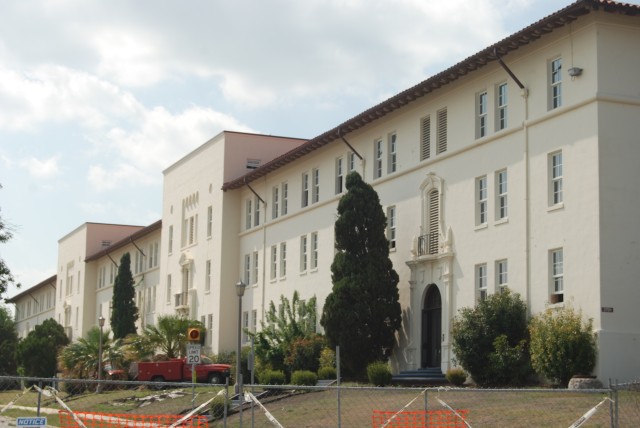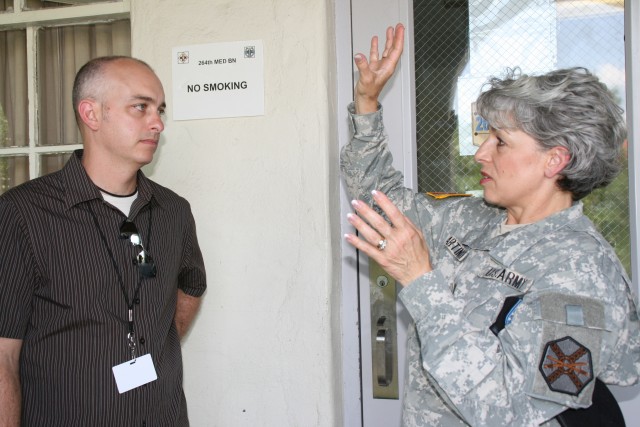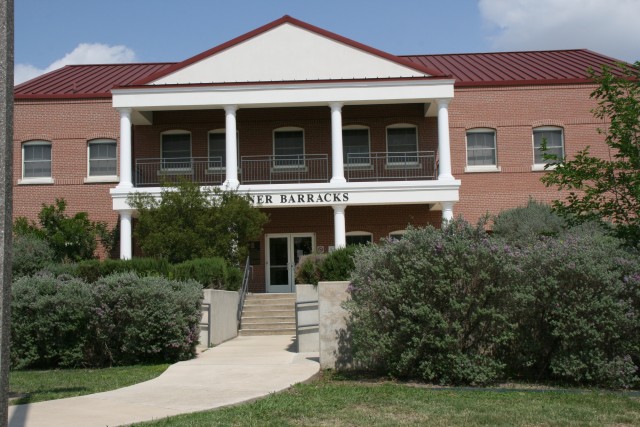FORT SAM HOUSTON, Texas -- A recent 100-percent barracks inspection by post leaders revealed a need for minor repairs, but a lack of any major issues that would compromise the safety or health of Soldiers, the garrison commander announced at a press conference May 2.
"Our mission was to identify the barracks facilities that failed to meet the standard for continued occupation and coordinate relocating if needed," said Col. Wendy Martinson, adding that inspection teams looked at 37 buildings and 6,700 barracks spaces. "What I'm pleased to report is that we discovered absolutely no life, health or safety issues."
The inspection, directed by the Installation Management Command, was an Army-wide effort to ensure the poor conditions discovered in a barracks at Fort Bragg, N.C., last month were not an indicator of a widespread problem. The issues at the Fort Bragg barracks, which were already under renovation, have been corrected.
The minor issues at the Fort Sam Houston barracks included light mildew and mold, a broken railing, and some broken bathroom fixtures, such as soap dishes.
"It's disappointing to see a railing broken or broken soap dish, but that happens," said Martinson, who likened the issues to repairs common to any dwelling, such as an apartment building.
During the inspection, some minor repairs were made on the spot and others were corrected soon after. The longer-term fixes that couldn't be taken care of in-house will be contracted out and completed in September.
For the most part, the Directorate of Public Works was able to make quick fixes, such as readjusting a light fixture or covering an exposed electrical outlet. Workers from DPW are a common sight around post and in the barracks since they process about 80 service orders a day.
Martinson said she was pleased by the lack of need for serious repairs, and attributed the findings to an influx of money dedicated to barracks upgrades and renovations. "In October 2006 we did a massive look," she said. "Over the past 18 months, we've invested a considerable amount of money in our sustainment, restoration and modernization of our Fort Sam Houston barracks."
In total, the installation has dedicated nearly $47 million to barracks renovations and upgrades in less than two years. Of that amount, the garrison has spent more than $18 million to renovate Building 2791, a project that falls under the Trainee Barracks Upgrade Program. When completed, Soldiers will relocate there from Building 2264, a barracks building that dates back to 1930 and is known to be the most "challenging" of the residences, Martinson said.
More than $7 million is programmed for Army Medical Action Plan-related improvements, which involve installing elevators and anti-scalding devices in barracks dedicated to Warriors in Transition, as well as converting rooms to meet American Disabilities Act standards.
Additionally, $7 million is dedicated to renovating Building 1350; more than $6 million is earmarked for the Trainee Barracks Improvement Program, which includes carpet, window, and door replacements in various barracks throughout post; and more than $1 million to replacing the roof and repairing the interior of Building 2791.
Along with current projects, Martinson outlined the way ahead for the post.
Over the next two years, three dorms and one enlisted barracks will be constructed as part of the Medical Enlisted Training Campus project, part of the Base Realignment and Closure initiative. The new facilities will cost more than $262 million.
Under the "Grow the Force" program, more than $102 million will be spent on a new 87-person enlisted barracks and a 1,200-person trainee barracks complex.
A barracks custom-designed for Warriors in Transition, a project planned to start next year, will cost more than $57 million and, further down the road, Military Construction projects to replace barracks will cost about $180 million. Also, renovation of several barracks buildings through the Trainee Barracks Upgrade Program will cost $52 million.
Finally, the privatization of Army lodging will cost $76 million. The project involves having a private entity run lodging; in Fort Sam Houston's case, Staybridge Suites. The company is slated to start building a 700-room facility in 2009.
In total, the post will be investing more than $777 million in barracks improvements, which, in turn, translates to a better quality of life for Soldiers.
The money is well spent, Martinson said. "Soldiers deserve accommodations that are commensurate with their service to our country."
(Elaine Wilson is from the Fort Sam Houston Public Information Office)






Social Sharing